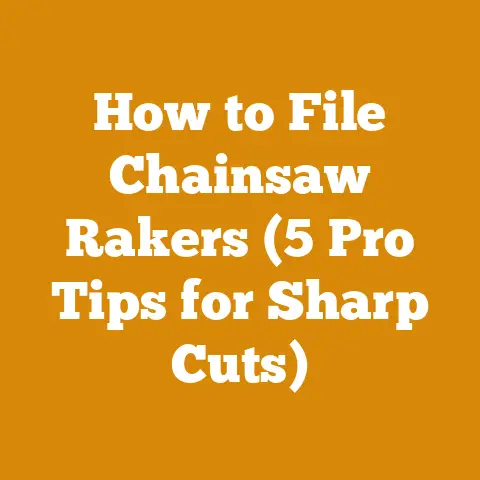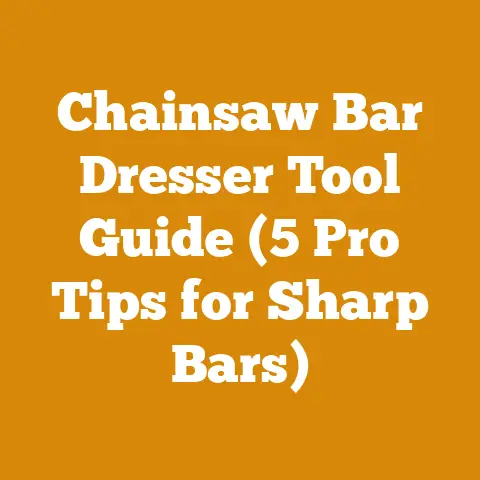Flywheel Shear Key Repair Tips (Expert Chainsaw Maintenance)
Have you ever been knee-deep in a wood-splitting project, only to be sidelined by a pesky chainsaw issue? Today, we’re diving deep into a common culprit: the flywheel shear key. More specifically, we’ll explore how to repair it and the costs associated with doing so. This isn’t just about fixing a chainsaw; it’s about understanding the economics of maintaining your tools and keeping your wood processing operation humming.
Flywheel Shear Key Repair Tips (Expert Chainsaw Maintenance)
Understanding the Flywheel Shear Key
The flywheel shear key is a small, often overlooked, but vitally important component in your chainsaw’s engine. It’s designed to protect the engine from catastrophic damage. It sits between the crankshaft and the flywheel, and its purpose is to shear (break) if the chainsaw blade suddenly stops or encounters an immovable object, preventing the engine from continuing to rotate and potentially causing severe internal damage. Think of it as a sacrificial fuse for your chainsaw.
Why Does it Break?
Shear keys break for a few reasons:
- Sudden Impact: Hitting a rock, nail, or other hard object with the chain.
- Chain Binding: The chain gets pinched and stops abruptly.
- Engine Overload: Pushing the chainsaw beyond its capacity.
- Wear and Tear: Over time, the key can weaken and eventually fail.
From my own experience, I’ve seen shear keys break most often when cutting near the ground, where hidden rocks and debris are prevalent. One time, I was clearing some fallen trees after a storm and didn’t realize a large piece of concrete was buried beneath the leaves. The chain hit it hard, and bang – the engine stalled, and the shear key had done its job.
Symptoms of a Broken Flywheel Shear Key
Recognizing the symptoms early can save you time and money. Here’s what to look for:
- Engine Won’t Start: This is the most common symptom. The engine might crank, but it won’t fire up.
- Weak Spark: The spark plug might be firing, but it’s weak and inconsistent.
- Engine Starts But Runs Poorly: The engine might start briefly, but it will run rough, stall easily, or lack power.
- Flywheel Spins Freely: If you can turn the flywheel by hand without the piston moving, the shear key is likely broken.
The Repair Process: Step-by-Step
Repairing a flywheel shear key is a relatively straightforward process that most chainsaw owners can tackle themselves. Here’s a detailed guide:
1. Safety First
- Disconnect the Spark Plug: Always disconnect the spark plug wire before working on your chainsaw to prevent accidental starting.
- Wear Gloves: Protect your hands from sharp edges and grease.
- Work in a Well-Ventilated Area: Avoid breathing fumes.
2. Gather Your Tools and Parts
- New Flywheel Shear Key: Make sure you have the correct replacement key for your chainsaw model.
- Socket Wrench or Combination Wrench: To remove the flywheel nut.
- Flywheel Puller (Optional but Recommended): This tool helps remove the flywheel without damaging it.
- Screwdriver (Flathead and Phillips): For removing covers and other components.
- Pliers: For various tasks.
- Hammer (Optional): For gently tapping the flywheel puller.
- Torque Wrench: To properly tighten the flywheel nut.
- Grease or Anti-Seize Compound: To lubricate the crankshaft and flywheel.
3. Accessing the Flywheel
- Remove the Starter Cover: This usually involves removing a few screws.
- Remove the Flywheel Nut: Use a socket wrench or combination wrench to loosen and remove the nut holding the flywheel in place. You might need to hold the flywheel to prevent it from turning while you loosen the nut. A piston stop tool can be helpful here, but be careful not to damage the piston.
- Remove the Flywheel: This is where the flywheel puller comes in handy. Attach the puller to the flywheel and tighten the center bolt to gradually pull the flywheel off the crankshaft. If you don’t have a puller, you can try gently tapping around the flywheel with a hammer, but be extremely careful not to damage it.
4. Inspect the Shear Key and Keyway
- Remove the Broken Shear Key: The broken shear key will likely be in two pieces, one in the flywheel and one in the crankshaft. Use pliers or a small screwdriver to remove the pieces.
- Inspect the Keyway: Check the keyway (the slot where the shear key sits) for any damage. Clean it thoroughly with a small brush or compressed air.
5. Install the New Shear Key
- Lubricate the Crankshaft: Apply a small amount of grease or anti-seize compound to the crankshaft where the flywheel sits.
- Install the New Shear Key: Place the new shear key into the keyway on the crankshaft. Make sure it sits flush and doesn’t protrude.
- Reinstall the Flywheel: Align the flywheel with the shear key and carefully slide it onto the crankshaft. It should slide on smoothly. If it doesn’t, check for any obstructions or damage.
6. Reassemble and Tighten
- Reinstall the Flywheel Nut: Tighten the flywheel nut to the manufacturer’s specified torque. This is crucial to ensure the flywheel is properly secured. Consult your chainsaw’s service manual for the correct torque specification. A torque wrench is essential for this step.
- Reinstall the Starter Cover: Replace the starter cover and secure it with the screws.
- Reconnect the Spark Plug: Reconnect the spark plug wire.
7. Test the Chainsaw
- Start the Engine: Try starting the chainsaw. If everything is installed correctly, the engine should start and run smoothly.
- Check for Vibration: Listen for any unusual vibrations or noises. If you notice anything, stop the engine and re-inspect the assembly.
Cost Breakdown: Materials, Labor, and Tools
Now, let’s get down to the nitty-gritty: the costs. Repairing a flywheel shear key involves several cost factors, including the shear key itself, specialized tools, and labor costs if you decide to hire a professional.
Material Costs
- Replacement Shear Key: The cost of a replacement shear key is typically quite low, ranging from $2 to $10. The price can vary based on the chainsaw model and the brand of the replacement part. You can usually find these at local hardware stores, chainsaw dealerships, or online retailers.
- Grease or Anti-Seize Compound: A small tube of grease or anti-seize compound will cost around $5 to $10. You likely already have this on hand if you regularly maintain your tools.
Tool Costs
- Flywheel Puller: A basic flywheel puller can cost between $15 and $40. While not strictly necessary, it makes the job much easier and reduces the risk of damaging the flywheel.
- Torque Wrench: A torque wrench is essential for properly tightening the flywheel nut. A decent quality torque wrench will cost between $30 and $100. If you plan to do any significant chainsaw maintenance, a torque wrench is a worthwhile investment.
- Socket Wrench Set: Most people already have a socket wrench set, but if you don’t, a basic set will cost around $20 to $50.
Labor Costs
- DIY: If you do the repair yourself, the labor cost is your time. Depending on your experience, the repair can take anywhere from 30 minutes to a couple of hours.
- Professional Repair: If you take your chainsaw to a repair shop, the labor cost will vary depending on the shop’s hourly rate and the complexity of the repair. Expect to pay anywhere from $50 to $150 for labor.
Total Cost Estimates
- DIY Repair: The total cost for a DIY repair, including the shear key, grease, and assuming you already have the necessary tools, will be around $7 to $20. If you need to purchase a flywheel puller and torque wrench, the total cost could be closer to $52 to $160.
- Professional Repair: The total cost for a professional repair, including parts and labor, will likely be between $52 and $160.
Case Study: DIY vs. Professional Repair
Let’s consider a scenario: You own a Stihl MS 271 chainsaw, and the flywheel shear key has broken. You have two options: repair it yourself or take it to a local repair shop.
- DIY: You purchase a replacement shear key for $5, a tube of grease for $8, and rent a flywheel puller from a local tool rental shop for $15. The total cost is $28. It takes you about an hour to complete the repair.
- Professional Repair: You take the chainsaw to a local repair shop, and they quote you $30 for the shear key and $80 for labor. The total cost is $110. The repair shop completes the repair in one day.
In this scenario, the DIY repair saves you $82, but it requires your time and effort. The professional repair costs more but saves you time and ensures the repair is done correctly.
Real-World Cost Data
To provide a more data-driven perspective, let’s look at some real-world cost data:
- Average Price of Chainsaw Repair (USA): According to HomeAdvisor, the average cost to repair a chainsaw in the United States is $70 to $150. This includes various types of repairs, but flywheel shear key repairs typically fall on the lower end of this range.
- Hourly Rate for Small Engine Repair (USA): The average hourly rate for small engine repair in the United States is $60 to $100. This rate can vary depending on the location and the experience of the technician.
- Price of Flywheel Shear Keys (Online Retailers): A quick search on Amazon or other online retailers shows that flywheel shear keys for common chainsaw models range from $2 to $10.
Cost Optimization Tips
Here are some tips to minimize the cost of flywheel shear key repairs:
Regular Maintenance Tasks and Costs
- Chain Sharpening: Sharpening the chain regularly is crucial for efficient cutting and preventing engine overload. You can sharpen the chain yourself using a file or a chain grinder, or you can take it to a professional.
- DIY Sharpening: A chainsaw file costs around $10 to $20.
- Professional Sharpening: Professional chain sharpening typically costs $10 to $20 per chain.
- Air Filter Cleaning: Clean the air filter regularly to ensure proper airflow to the engine. A dirty air filter can cause the engine to run poorly and overheat.
- Cost: Air filter cleaner costs around $5 to $10.
- Spark Plug Replacement: Replace the spark plug annually or as needed. A faulty spark plug can cause starting problems and poor engine performance.
- Cost: A spark plug costs around $5 to $10.
- Fuel Filter Replacement: Replace the fuel filter annually or as needed. A clogged fuel filter can restrict fuel flow to the engine.
- Cost: A fuel filter costs around $5 to $10.
- Chain Oil: Use high-quality chain oil to lubricate the chain and bar. Proper lubrication is essential for preventing wear and tear.
- Cost: A gallon of chain oil costs around $10 to $20.
- Bar Maintenance: Regularly clean and inspect the bar for wear and damage. Replace the bar as needed.
- Cost: A new chainsaw bar can cost between $30 and $100, depending on the size and brand.
Annual Chainsaw Maintenance Budget
Here’s an example of an annual chainsaw maintenance budget for a homeowner who uses their chainsaw for occasional firewood cutting and tree trimming:
- Chain Sharpening: $20 (professional sharpening)
- Air Filter Cleaner: $8
- Spark Plug: $7
- Fuel Filter: $7
- Chain Oil: $30 (3 gallons)
- Bar Maintenance: $0 (assuming no bar replacement needed)
- Flywheel Shear Key (Contingency): $10
- Total Annual Budget: $82
For a professional logger or arborist who uses their chainsaw daily, the annual maintenance budget will be significantly higher due to increased wear and tear.
Let’s explore some broader cost considerations.
Timber Costs
- Standing Timber: If you’re harvesting your own timber, the cost will depend on the species, size, and quality of the trees, as well as the accessibility of the land. Timber prices vary significantly by region and market conditions.
- Average Price of Standing Timber (USA): According to the USDA Forest Service, the average price of standing timber in the United States varies widely by species and region. For example, hardwood timber in the Northeast might cost $50 to $100 per thousand board feet, while softwood timber in the Pacific Northwest might cost $200 to $400 per thousand board feet.
- Purchased Logs: If you’re purchasing logs, the cost will depend on the species, size, and quality of the logs, as well as the distance they need to be transported.
- Average Price of Logs (USA): The average price of logs in the United States also varies widely. Hardwood logs might cost $100 to $300 per thousand board feet, while softwood logs might cost $300 to $500 per thousand board feet.
Labor Costs
- Logging Crew: If you’re hiring a logging crew to harvest timber, the cost will depend on the size of the crew, the complexity of the job, and the hourly rate.
- Average Hourly Rate for Logging Crew (USA): The average hourly rate for a logging crew in the United States is $50 to $150 per hour.
- Firewood Handlers: If you’re hiring people to handle firewood, the cost will depend on the hourly rate and the number of hours worked.
- Average Hourly Rate for Firewood Handlers (USA): The average hourly rate for firewood handlers in the United States is $15 to $25 per hour.
Equipment Costs
- Chainsaws: As we’ve discussed, chainsaw maintenance is a significant cost. In addition to maintenance, you’ll also need to factor in the cost of the chainsaw itself.
- Average Price of Chainsaw: A good quality chainsaw for homeowner use will cost between $200 and $500. A professional-grade chainsaw will cost $500 or more.
- Log Splitters: If you’re processing firewood, you’ll likely need a log splitter.
- Average Price of Log Splitter: A hydraulic log splitter can cost between $1,000 and $3,000.
- Skid Steers and Tractors: For larger wood processing operations, you might need a skid steer or tractor to move logs and firewood.
- Average Rental Cost of Skid Steer: The average rental cost of a skid steer is $200 to $400 per day.
- Average Rental Cost of Tractor: The average rental cost of a tractor is $150 to $300 per day.
Transportation Costs
- Fuel: Fuel costs are a significant expense in wood processing. You’ll need fuel for your chainsaw, log splitter, and any vehicles used to transport logs and firewood.
- Vehicle Maintenance: Vehicle maintenance is another cost to consider. You’ll need to maintain your trucks and trailers to keep them running reliably.
Permits and Licenses
- Logging Permits: In some areas, you’ll need a logging permit to harvest timber. The cost of a logging permit will vary depending on the location and the size of the harvest.
- Business Licenses: If you’re selling firewood, you might need a business license. The cost of a business license will vary depending on the location.
Drying Time and Storage Costs
- Drying Time: Firewood needs to be dried before it can be burned efficiently. The drying time will depend on the species of wood, the climate, and the storage conditions.
- Estimating Drying Time: As a general rule, hardwood firewood needs to dry for at least six months, while softwood firewood needs to dry for at least three months.
- Storage Costs: You’ll need a place to store your firewood while it’s drying. This could be a simple woodpile covered with a tarp, or it could be a more elaborate storage shed.
Market Rates for Firewood
- Average Price per Cord of Firewood (USA): According to various sources, the average price per cord of firewood in the United States is $150 to $400. The price will vary depending on the species of wood, the location, and the season.
Case Studies: Budgeting for Wood Harvesting and Firewood Preparation
Let’s look at a couple of case studies to illustrate how to budget for wood harvesting and firewood preparation.
Case Study 1: Small-Scale Firewood Preparation
A homeowner wants to prepare 5 cords of firewood for their personal use. They plan to harvest the wood from their own property and split it themselves.
- Timber Costs: $0 (harvesting from their own property)
- Chainsaw Maintenance: $50 (annual maintenance budget)
- Log Splitter Rental: $200 (renting a log splitter for a weekend)
- Fuel: $50 (for chainsaw and log splitter)
- Transportation: $0 (transporting wood on their own property)
- Permits and Licenses: $0 (not required for personal use)
- Storage: $0 (using a simple woodpile covered with a tarp)
- Total Cost: $300
- Cost per Cord: $60
Case Study 2: Commercial Firewood Business
A small business owner wants to start a firewood business. They plan to purchase logs, split them, and sell them to customers.
- Log Costs: $1,000 (purchasing 10 cords of logs)
- Chainsaw Maintenance: $300 (annual maintenance budget)
- Log Splitter Purchase: $2,000 (purchasing a hydraulic log splitter)
- Fuel: $200 (for chainsaw and log splitter)
- Transportation: $500 (for transporting logs and firewood)
- Permits and Licenses: $100 (business license)
- Storage: $500 (building a simple storage shed)
- Total Cost: $4,600
- Cost per Cord: $460
- Selling Price per Cord: $300 (average market rate)
- Profit/Loss: -$1,600 (loss)
In this case, the business owner needs to find ways to reduce their costs or increase their selling price to make the business profitable.
Actionable Takeaways and Next Steps
Repairing a flywheel shear key is a manageable task with the right tools and knowledge. By understanding the costs involved and implementing cost optimization strategies, you can keep your chainsaw running smoothly without breaking the bank. Here are some actionable takeaways:
- Diagnose the Problem: If your chainsaw won’t start or runs poorly, check the flywheel shear key.
- Gather Your Tools: Make sure you have the necessary tools before starting the repair.
- Follow the Steps: Follow the step-by-step repair process carefully.
- Consider the Costs: Weigh the costs of DIY repair versus professional repair.
- Optimize Your Budget: Implement cost optimization strategies to minimize your expenses.
As a next step, I recommend checking your owner’s manual for specific instructions related to your chainsaw model and the proper torque specifications for the flywheel nut. Also, visit your local hardware store or online retailer to compare prices for replacement parts and tools. Remember, a well-maintained chainsaw is a safe and efficient tool that can save you time and money in the long run.
Keep your chain sharp, your engine running smoothly, and your woodpile growing!






